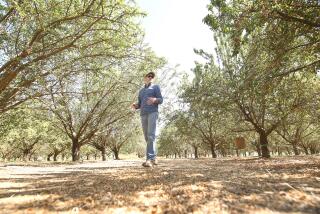Old Technology Offers New Way to Fight Crop Pest
Rattling and rumbling the way it does, the conveyor-belt contraption hardly seems a model of innovation.
But the old packinghouse assembly line, once used to wash fruit but set up in Fillmore to purge produce of the dreaded glassy-winged sharpshooter, is among the newest weapons in the war against the crop-ravaging insect.
A year and a half into a statewide campaign to ensure that citrus shipments are sharpshooter-free, agricultural officials are looking for new ways to rid loads of the voracious pest, which has wreaked havoc on California’s wine industry and could be damaging other crops as well.
Current methods, such as spraying water on the fruit prior to shipment, do not always get the bugs out, growers and packers say.
A subcommittee of the state’s glassy-winged sharpshooter task force met this week in Bakersfield to discuss more effective tactics, reviewing everything from high-pressure washes to pesticide treatments prior to harvest.
The assembly line system, which has been used for about a year by a handful of Ventura County citrus growers, is expected to be high on the list of recommended remedies.
“It’s not much to look at, but it sure works,” said Mike Mobley, who owns a Santa Paula-based ranch management company that operates the machinery on behalf of the Bee Sweet packinghouse near Fresno.
Nine Ventura County citrus growers who ship to that packinghouse first run their produce through the scrub line, which uses rollers and brushes to wipe the fruit clean.
“We had to come up with a better way to eliminate the sharpshooter from our shipments,” Mobley said. “We were able to take this equipment, which had been sitting around collecting rust, and turn it into an effective tool.”
With sharpshooter infestations reported from San Diego to the San Joaquin Valley, state and federal officials are devoting $20 million a year to curbing the spread of the needle-nosed insect.
More than 60 research projects are underway across California to battle the bug, an exotic pest discovered in the state in the late 1980s after being accidentally brought in from Mexico.
Unlike other pests that feed on fruit, the sharpshooter does its damage by delivering a bacterium that causes Pierce’s disease, which clogs water-carrying vessels in plants and starves them of nutrients until they wither and die. Vineyards are particularly susceptible, although the disease also strikes almond trees, oleanders and other plants.
Though the disease has plagued agricultural areas for more than a century, the arrival of the aggressive, fast-moving sharpshooter has fueled its spread.
The worst damage has occurred in Temecula, where 1,000 acres of wine grapes have been destroyed in recent years, costing growers $40 million.
As part of the ongoing effort to prevent the pest from moving into other winemaking regions, state regulators have invoked a range of restrictions on shipments of nursery stock and other agricultural products.
In Ventura County, for example, local inspectors must examine every leaf of every nursery plant--except cut flowers--for sharpshooter eggs before they leave the county. Citrus products also must meet certain conditions to prevent sharpshooters from being carried to areas free of infestation.
But Jay Van Rein, spokesman for the California Department of Food and Agriculture, said some packinghouses have continued to receive shipments with sharpshooters on board, prompting the search for better ways of keeping the bugs at bay.
Agricultural officials are scheduled to report their findings at an Aug. 14 subcommittee meeting.
“Some of the methods we have in place haven’t proven as effective as we would like,” Van Rein said. “Our goal is to make sure that [growers] are not artificially transporting this thing around the state.”
That effort is especially significant in Ventura County, where citrus groves swarm with sharpshooters at certain times of the year.
The yellow-eyed insect does not have the same deadly effect on citrus trees that it has on vineyards.
Still, agricultural researchers recently launched a study to determine whether there are links between the thick sharpshooter populations in Ventura County and a host of emerging problems affecting fruit and trees.
Deputy Agricultural Commissioner Alan Laird said the high pest populations also have made it hard for growers to rid shipments of sharpshooters. He said packinghouse managers simply reject loads when the bug is discovered, sending them back to Ventura County and costing growers time and money.
That is how the Bee Sweet packinghouse came to set up the old wash line in a Fillmore equipment yard.
The packer, which pulls fruit from about 400 acres in Ventura County, continued to receive shipments peppered with sharpshooters, despite the fact that growers were following rules for removing the bugs.
The assembly line has eliminated the problem, with Mobley and a crew of workers able to clean as many as seven truckloads a day.
“They will reject a load if they find just one [sharpshooter], so if you can’t eliminate all of the sharpshooters, it’s a total waste of time,” said Mobley, noting that Bee Sweet is paying the cost of the entire operation.
“It’s very impressive what we’ve been able to accomplish,” he said. “I guess you could call it cutting-edge stuff.”
More to Read
Inside the business of entertainment
The Wide Shot brings you news, analysis and insights on everything from streaming wars to production — and what it all means for the future.
You may occasionally receive promotional content from the Los Angeles Times.










